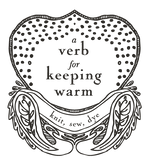
I've always loved to hike - though it was not until I became an natural dyer that I began to really learn and honor the practice of plant identification.

I went from seeing nature as one, big, beautiful heap, an identifiable tree here and there like a eucalyptus with its blade-like, silver colored leaves - to really seeing nuances within a cluster of trees, shrubs, and ground coverings. I've learned to identify the different types of eucalyptus and to recognize the plants which grown around the eucalyptus. I came to see all plants, trees, roots, and fungi as a potential source of dye.

Before collecting any thing, I always identify it first. This is a good safety protocol - as a plant or fungi could be poisonous. It is possible to identify plants and fungi over the internet and through the use of plant and fungi-based field guides and books. I don't like to carry a lot with me when I hike - so carrying field-based guides are not really my thing. Also, sometimes where I am hiking doesn't have cell service, so using my phone to search the internet for answers is not always an option. I like to keep a journal where I can draw a map, and indicate where I found the plant. I like to take a leaf and press into the journal and record any other noticeable attributes of the plant - height, color of the bark, etc. I record the date of when I took the leaf. Then, once I get home, I can research and identify the plant. Since I have made a map, I can go back to the plant if indeed it it a good candidate for dyeing. Also, taking a friend can be a good idea, two heads can be better than one - as sometimes a friend can identify a plant I am unfamiliar with.
Through the identification process, it is possible to learn whether or not the plant is invasive. I like to choose to work with invasive plants first and give the native plants a leg up. By taking the out the invasive, there is more room for a native plant to take root. Also, before collecting, and during the identification process, I research to see if others have dyed with it. A plant can not be ruled out completely just because research isn't readily apparent whether or not it can be used as a dye plant. Though, I find that when dyeing, trying to work with known dye plants can provide more fruitful results, for example dyed instead of undyed, and color that stays on the textile-based material longer then a week or so.
When Adrienne and I arrived in Montana, the first thing we did was walk the land we were staying on. We began to take note of the plants, trees, and fungi. We were especially interested in what we would find since it had already been getting cold and things were really beginning to die back. That said, we still found a lot of options.
There were three plants we honed in on: curly dock, goldenrod, and yarrow.


While looking for dye plants, I find myself looking at textures and patterns - and thinking how I could incorporate them into my work - perhaps on a piece of fabric through using resist-dyeing techniques. Or through sewn piecework. Or a knitted stitch pattern.




One of my absolutely favorite things about being a natural dyer is the fact that it is another way to understand the natural world. I know and am able to identify so many more plants and trees since becoming a natural dyer. And because of that, I feel like I am much more part of nature. Do you forage for dye materials? Do you have any useful tips or tricks? Favorite plants to work with? Or unexpected findings or results? I would love to know.

Tomorrow on the blog - I will give you a recipe to work with curly dock.
Also, tomorrow is Verb's 4 Year Anniversary Party - 10-6pm - please do come if you can. There are a lot of fun activities planned - like a dyeing party at noon.

